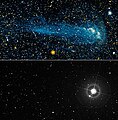File:Mira In UV And Visible Light.jpg
As this composite demonstrates, the tail is only visible in ultraviolet light (top), and does not show up in visible light (bottom). Incidentally, Mira is much brighter in visible than ultraviolet light due to its low surface temperature of about 3,000 kelvin (about 5,000 degrees Fahrenheit).
The Galaxy Evolution Explorer, one of NASA's Small Explorer class missions, is the first all-sky survey in ultraviolet light. It found Mira's tail by chance during a routine scan. Since the mission's launch more than four years ago, it has surveyed millions of galaxies and stars. Such vast collections of data often bring welcome surprises, such as Mira's unusual tail.
The visible-light image is from the United Kingdom Schmidt Telescope in Australia, via the Digitized Sky Survey, a program affiliated with the Space Telescope Science Institute, Baltimore, Md.

